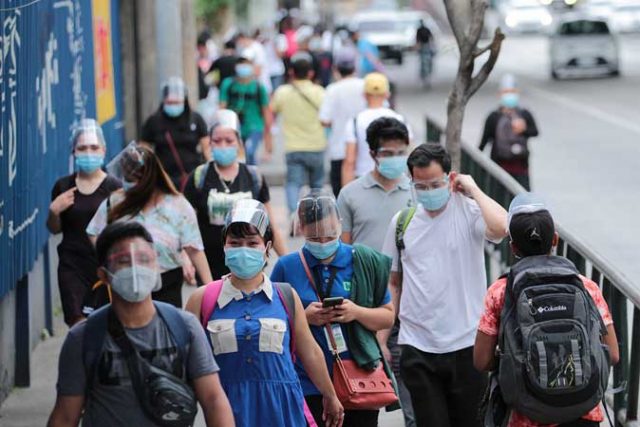Police catch 150,000 quarantine violators

PHILIPPINE police on Sunday reported 149,963 quarantine violators during the two-week strict lockdown in the capital region that ended on Aug. 20.
Of the total, 100,946 did not follow minimum health standards such as wearing face shields and masks, 40,705 violated the 8 p.m. to 4 a.m. curfew and 8,312 unnecessarily went out of their homes, police said.
Police also apprehended 437,598 quarantine violators in four provinces near the Philippine capital — Bulacan, Laguna, Cavite and Rizal.
Of the total, 335,871 violated minimum health standards, 79,910 were curfew violators and 21,817 unnecessarily went out.
Nationwide, there were 690,320 quarantine violators during the two-week period. Most of them or 79% got a warning, 13% were fined and 7% were subjected to community service.
The lockdown in the capital region has since been eased to a modified enhanced community lockdown until Aug. 31.
Meanwhile, the Philippines will start making its own vaccines as early as 2022 so it does not suffer from global supply issues in the future, according to the Department of Science and Technology.
The country will use fill-and-finish manufacturing, where manufacturers import antigens in bulk and then package them in vials for commercial distribution, Science and Technology Secretary Fortunato T. Dela Peña told
BusinessWorld
Live on One News.
The agency is leading vaccine evaluation and selection, while the Trade department helps companies that seek to make vaccines locally, he said.
“Realistically, we probably will have the kind of arrangement where some (of the vaccines) will be locally produced and some will be procured outside,” he added.
The country struggles to vaccinate its entire adult population amid a spike in infections believed to be triggered by the highly contagious Delta coronavirus variant.
DAILY TALLY
The Health department reported 16,044 coronavirus infections on Sunday, bringing the total to 1.84 million.
The death toll rose to 31,810 after 215 more patients died, while recoveries increased by 13,952 to 1.68 million, it said in a bulletin.
There were 125,900 active cases, 93.8% of which were mild, 3.4% did not show symptoms, 1.2% were severe, 0.94% were moderate and 0.6% were critical.
DoH said 460 duplicates had been removed from the tally, 427 of which were recoveries and one was a death. It added that 120 recoveries had been reclassified as deaths. Six laboratories failed to submit data on Aug. 20.
Mr. Dela Peña said the long-term plan is to “develop vaccines on our own” under a local virology and vaccine institute.
Presidential spokesman Herminio L. Roque, Jr. last week said the P1.28-billion budget for the Virology Science and Technology Institute would be included in the 2022 national budget.
He said the government would set aside P45.37 billion for coronavirus booster shots under the proposed P5.024-trillion budget for next year. The budget for the booster shots would only be provided if the government can raise money for it.
The Philippines has approved the emergency use of eight coronavirus vaccines, including those made by Pfizer, Inc., AstraZeneca Plc, Moderna, Inc., Russia’s Gamaleya Research Institute of Epidemiology and Microbiology, Sinovac Biotech Ltd. and Sinopharm Group Co., Ltd.
The country has received about 48.5 million doses of coronavirus vaccines.
As of Sunday, 12.88 million or 11.91% of Filipinos have been fully vaccinated, according to the John Hopkins University’s COVID-19 dashboard.
President Rodrigo R. Duterte last week relaxed the lockdown in Metro Manila after placing it under an enhanced community quarantine for two weeks until Aug. 20.
The increase in Metro Manila’s coronavirus cases was 48% two weeks ago and 72% three weeks ago, the OCTA Research Group from the University of the Philippines said on Sunday. The seven-day positivity was 22%.
“The lockdown in the form of enhanced community quarantine helped reduce the growth rate of new COVID-19 cases,” it said in a report. “While new cases are still increasing, the decreasing growth rate is consistent with a decreasing reproduction number. In other words, the surge has slowed down in the National Capital Region.”
The reproduction number in Metro Manila decreased to 1.67 from 1.9. But the decrease was slower this month compared with April due to the presence of the Delta variant and as people moved more freely, OCTA said.
“The downward trend in new cases may happen in the next few weeks, but this will require sustained efforts in pandemic management over the next four weeks by the local, National Government and the public,” it added.
Health authorities have said the effects of the strict lockdown in the capital region would not be felt immediately. —
Kyle Aristophere T. Atienza
and
Bianca Angelica D. Añago
